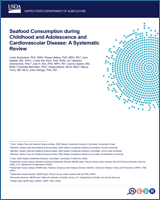The contents of this document may be used and reprinted without permission. Endorsements by NESR, NGAD, CNPP, FNS, or USDA of derivative products developed from this work may not be stated or implied.
NCBI Bookshelf. A service of the National Library of Medicine, National Institutes of Health.
TECHNICAL ABSTRACT
Background
- This important public health question was identified by the U.S. Departments of Agriculture (USDA) and Health and Human Services (HHS) to be examined by the 2020 Dietary Guidelines Advisory Committee.
- The 2020 Dietary Guidelines Advisory Committee, Dietary Fats and Seafood Subcommittee conducted a systematic review to answer this question with support from the Nutrition Evidence Systematic Review (NESR) team.
- The goal of this systematic review was to examine the following question: What is the relationship between seafood consumption during childhood and adolescence (up to 18 years of age) and risk of cardiovascular disease?
Conclusion Statement and Grade
- Insufficient evidence is currently available to accurately determine the relationship between seafood consumption during childhood and adolescence and risk of developing cardiovascular disease. (Grade: Grade not assignable)
Methods
- A literature search was conducted using four databases (i.e., PubMed, Cochrane, Embase, and CINAHL) to identify articles that evaluated the intervention or exposure of seafood consumption during childhood and adolescence and the outcomes of cardiovascular disease. A manual search was conducted to identify articles that may not have been included in the electronic databases searched. Articles were screened by two NESR analysts independently for inclusion based on pre-determined criteria.
- Data extraction and risk of bias assessment were conducted for each included study, and both were checked for accuracy. The Committee qualitatively synthesized the body of evidence to inform development of a conclusion statement, and graded the strength of evidence using pre-established criteria for risk of bias, consistency, directness, precision, and generalizability.
Summary of the evidence
- Four articles, two randomized controlled trials and two prospective cohort studies, met inclusion criteria for this systematic review.
- The 2020 Dietary Guidelines Advisory Committee used the following seafood definition: marine animals that live in the sea and in freshwater lakes and rivers. Seafood includes fish (e.g., salmon, tuna, trout, and tilapia) and shellfish (e.g., shrimp, crab, and oysters).
- Few articles were identified that examined the relationship between seafood intake during childhood and adolescence and blood pressure, lipid levels, and cardiovascular-related mortality, and no articles examined the relationship with incidence of cardiovascular disease.
- Two of four included articles had serious methodological limitations that made interpretation of the results difficult.
- Evidence was insufficient and no conclusion could be drawn.
Contents
Suggested citation:
Snetselaar L, Bailey R, Sabaté J, Van Horn L, Schneeman B, Kim JH, Spahn J, Bahnfleth C, Butera G, Terry N, Obbagy J. Seafood Consumption during Childhood and Adolescence and Cardiovascular Disease: A Systematic Review. July 2020. U.S. Department of Agriculture, Food and Nutrition Service, Center for Nutrition Policy and Promotion, Nutrition Evidence Systematic Review. Available at: https://doi.org/10.52570/NESR.DGAC2020.SR0504
In accordance with Federal civil rights law and U.S. Department of Agriculture (USDA) civil rights regulations and policies, the USDA, its Agencies, offices, and employees, and institutions participating in or administering USDA programs are prohibited from discriminating based on race, color, national origin, religion, sex, gender identity (including gender expression), sexual orientation, disability, age, marital status, family/parental status, income derived from a public assistance program, political beliefs, or reprisal or retaliation for prior civil rights activity, in any program or activity conducted or funded by USDA (not all bases apply to all programs). Remedies and complaint filing deadlines vary by program or incident.
Persons using assistive technology should be able to access information in this report. For further assistance please email vog.ADSU@RSEN.NF.MS.
Persons with disabilities who require alternative means of communication for program information (e.g., Braille, large print, audiotape, American Sign Language, etc.) should contact the responsible Agency or USDA’s TARGET Center at (202) 720-2600 (voice and TTY) or contact USDA through the Federal Relay Service at (800) 877-8339. Additionally, program information may be made available in languages other than English.
To file a program discrimination complaint, complete the USDA Program Discrimination Complaint Form, AD-3027, found online at How to File a Program Discrimination Complaint and at any USDA office or write a letter addressed to USDA and provide in the letter all of the information requested in the form. To request a copy of the complaint form, call (866) 632-9992. Submit your completed form or letter to USDA by:
- (1)
mail: U.S. Department of Agriculture, Office of the Assistant Secretary for Civil Rights, 1400 Independence Avenue, SW, Washington, D.C. 20250-9410;
- (2)
fax: (202) 690-7442; or
- (3)
email: vog.adsu@ekatni.margorp.
USDA is an equal opportunity provider, employer, and lender.
Related citation: Dietary Guidelines Advisory Committee. Scientific Report of the 2020 Dietary Guidelines Advisory Committee: Advisory Report to the Secretary of Agriculture and the Secretary of Health and Human Services. July 2020. U.S. Department of Agriculture, Agricultural Research Service. Available at: https://doi.org/10.52570/DGAC2020
